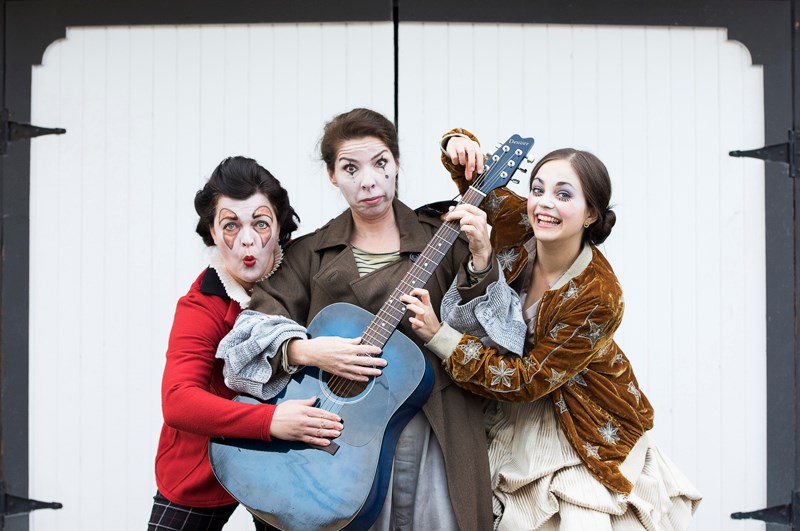Near the end of The Producers, Franz Liebkind, the alt-playwright responsible for “Springtime for Hitler,” berates laughing playgoers and yells:
“You are the audience! I am the author! I outrank you!”
Issues of hierarchy didn’t need to be addressed during rehearsals for Holy Mo!, director Kerry van der Griend reports from his East Vancouver abode.
Van der Griend has what appears to be the delicate task of giving stage directions and taking script advice from the same person: actor and Holy Mo! author Lucia Frangione.
Frangione initially unveiled the characters Follie, Buffoona and Guff during her first foray into professional theatre more than 20 years ago.
Frangione wanted to create a piece “as epic as Cecil B. DeMille’s The Ten Commandments on a shoestring budget with three women and no camels,” she states in a Pacific Theatre blog.
As decades drifted by, Frangione found herself missing her three stooges in search of a Moe. She opted to gather the clown trio for new version of Holy Mo! which examines what Frangione calls “the dark underbelly of the nativity story.”
Some renditions of the nativity story conclude with three wise men bestowing gifts on the newborn saviour.
“What people forget is what happened in the ensuing months,” van der Griend explains.
King Herod, who was a real-life king of Judea, is portrayed in the Bible as a tyrant and decidedly not a baby person.
In Holy Mo!, Caesar lectures Herod about Pharisees being “up in my grill,” as well as Herod’s role as Caesar’s “client king” of Judea.
“Hey, you’re a heebee, right?” Caesar asks.
“We prefer the term Children of God,” Herod responds.
The tension in Holy Mo! is rooted in what the characters want to talk about and what they want to ignore.
Amid biblical bloodshed and Flashdance references, we find one character who loves Santa Claus, another who hates Christmas, and a third chasing the truth of the nativity story.
“Some of them want to tell this dark part of the story and some of them don’t so it’s kind of a mirror of what goes in on each of us,” van der Griend explains, describing the theme as “inner conflict between the darkness and the light, between the sorrow and the joy.”
Asked how he brings those concepts to the stage, van der Griend laughs.
“With a lot of help,” he says.
Besides Frangione, the play is also buttressed by actor Anita Wittenberg, who first played Guff in 1996. Jess Amy Shead plays the “mischievous, lively, spritely clown” Buffoona.
Part of the challenge for the director was to remain faithful to the script while invoking the feeling of spontaneity, as though the cast were a wandering troupe of Italian comedians zigging and zagging through a bygone era.
“We had to … completely master the language, the movement, the blocking and everything to make it look as though it was improvised,” he says.
For Frangione, the play is a mash-up of the nativity, Santa Claus and a few “modern-day narcissists.”
While the play is silly and satirical, Frangione also views it as a direct examination of her faith.
“We put God on stage,” she states.
And between the flourishes and political ranting, Frangione peels back the layers of the nativity and what it means to her.
The play is scheduled to end its run with a final performance Dec. 31.



